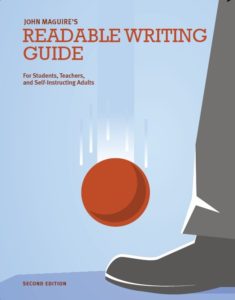Here’s an endorsement letter from Amy Horst, a veteran singing instructor assigned to teach a writing-intensive course.
I have spent my career teaching singing and performing as a soprano singer. In the past five years, I have begun teaching writing in some of my classes as part of the University of Hawaii’s Writing Intensive program.
Because I just started teaching writing five years ago, my confidence in my abilities needed a boost. Beyond this, I really needed specifics that I could rely on to help my students write better. I’m used to teaching the foundational skills of singing: posture, breathing, and jaw/tongue position. I also teach foundations of music reading/writing: note names, rhythms, and scales. Until I found the College Writing Guide, I didn’t know that writing could be taught in a similarly systematic, skills-based manner.
I found the College Writing Guide in a frantic late night internet search for resources, after I realized that my students needed much more help than I was providing. My light-bulb moment came when I asked students to name some verbs, and one student hesitantly asked if the word “of” was a verb. I don’t have any formal training in how to teach students to write well, or at all. During my schooling, teachers generally noted that my writing demonstrated some skill and an occasional flair of possible talent. But most of my time and talent went to studying singing, so I didn’t pay too much attention. Suddenly, I was eager for specific information.
The most surprising aspect of the College Writing Guide, initially, was John’s personal accessibility. He provided individual and small group coaching by phone on several occasions. He answered specific questions that I had about how to handle issues with my students’ writing.
Ultimately, the most surprising and reassuring part of using the College Writing Guide has been the skills-based approach to improving writing. As a voice teacher, I know how to tell students to demonstrate proper posture for singing. Posture makes singing possible. Now I understand that teaching students to identify and use concrete nouns works the same way. Concrete nouns make writing possible. Similarly, breathing drives singing; and active verbs drive writing. These skills make writing possible, and most of all, they make writing clear.
My students come from a wide variety of backgrounds. A class of 25 students may include 15 languages spoken by the students. I asked John several times how to handle teaching sentence structure in connection with the CWG skills-based lessons, because my students’ grasp of sentence structure in written English varies widely. While we have discussed several possible options, I have discovered, after five semesters, that simply focusing on skill-building as the CWG suggests improves sentence structure. After a semester of working through the skills in the CWG, students who struggled with sentence structure demonstrate increased clarity and coherence in their sentence structure. It turns out that as long as we focus on concrete nouns, people language, active verbs, and the writing techniques build on those skills, sentence structure comes into focus.
Decades of teaching singing made me feel unprepared to teach writing. The College Writing Guide and John Maguire himself helped me understand that singing skills and writing skills can both be taught sequentially, specifically, and effectively. And that, as my voice teacher self would say, is something to sing about.
####



Leave a Reply